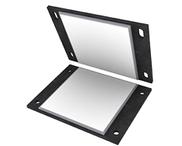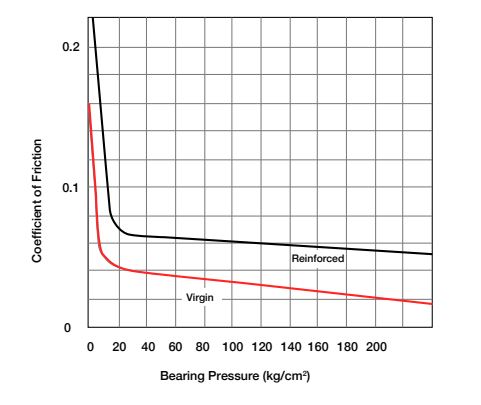
PTFE Expansion Bearings
PTFE Expansion Bearings come in a variety of formats including STC (#8 Mirror Finish SS upper and PTFE lower connection)) and TTC (PTFE upper and PTFE lower connection).
PTFE Slide Bearing systems offer a low profile solution for allowing relative movement between structural elements.
Thermal cycles, seismic activity, variable loading conditions, and long term material changes are some of the conditions that must be accommodated by the structural system. Typical applications are at floor and roof framing connections along expansion joint lines in large structures, truss base plates, pipe supports, heat exchangers, and other process equipment.
The Benchmark STC PTFE Expansion Bearing slide bearing system consists of an upper and a lower component. The upper element is attached to the upper structural element with the #8 Mirror Finish Stainless Steel face down, while the lower element is attached to the lower structural element with the 3/32" Virgin PTFE face up. The slide bearing elements can be supplied with holes and slots to match the opening in the structural system.
The Benchmark TTC PTFE Expansion Bearing slide bearing system consists of 3/32" glass-filled PTFE bonded to a 10 gage steel (carbon or stainless steel) backing plate. The upper element is attached to the upper structural element with the PTFE face down, while the lower element is attached to the lower structural element with the PTFE face up. The slide bearing elements can be supplied with holes and slots to match the opening in the structural system.
Typical PTFE Expansion Bearing Design:
The upper element is sized to provide full coverage of the lower element throughout the range of allowed movement. This ensures that full contact is maintained on the lower element and allows the upper element to provide full coverage for the lower element. Following this best practice approach for element sizing will maximize product life cycle by eliminating partial loading situations and minimizing the risk that foreign material will enter the sliding interface.
PTFE COEFFICIENT OF FRICTION Effect of Load:
The coefficient of friction of PTFE materials is dependent on many variables, including pressure, sliding velocity and temperature. A design coefficient of friction of 0.1 for unified PTFE or 0.12 for reinforced PTFE will give a significant margin of safety when all operating conditions cannot accurately be predicted; but the figures in practice will normally be considerably less.
There are many applications in industry where relative movement between two surfaces must be accommodated.
These applications call for high load capacity at low speed, meaning self lubricating PTFE is an ideal material to be employed. Benchmark has amassed a great deal of experience in designing and supplying custom made expansion bearings to address this issue.
PTFE structural expansion bearings are custom designed to accommodate expansion, contraction and other reciprocating motions of any structure that moves as a result of thermal, seismic or differential forces.

Key Advantages of PTFE Expansion Slide Bearing:
- Simplistic design and ease of fabrication and installation results in cost efficiency.
- Costs of a construction can be reduced by designing for expansion rather than strain.
- Coefficient of friction over the bearing surface remains constant, even under worst case scenarios.
- Slide Bearings are maintenance free, PTFE is inherently self-lubricating
Design and Selection:
Benchmark offers a custom production, based on many years’ experience of the manufacturing of PTFE Slide Expansion Bearings. Low friction slide plates with a coefficient of friction less than 0.1 are
available.
PTFE Slide Bearings are designed specifically for the loads and movements required. The standard slide plate assemblies FTFE to Stainless Steel and PTFE to PTFE are designed to operate efficiently at the loadings shown.
Sliding Face Temperature and Thermal Insulation:
It is important to note that the maximum service temperature relates to the sliding face of the bearing assembly. As a rule of thumb, under normal conditions the temperature falls by 200°C for every 100mm from the heat source (in ambient air) for example, a typical horizontal vessel operating at 500°C will have a bottom-of-saddle temperature of about 150°C.
Where PTFE is used and the temperature of the bearing face is likely to exceed 200˚C by conduction
through the bearing components, a thermal barrier can be interposed between the heat source and the sliding unit. Thermal barriers are not usually needed
Slide Bearing Materials:
- Virgin PTFE sliding on stainless steel. This configuration gives the lowest possible coefficient of friction for unlubricated materials. PTFE is suitable for use at temperatures up to 200°C.
- 25% glass-filled PTFE sliding on stainless steel. The use of glass-filled PTFE allows higher bearing pressure, so that more compact designs can be used. The coefficient of friction is slightly higher than with virgin PTFE.
- Graphite sliding on stainless steel. Graphite is normally used where the sliding surface is at high
temperature. Graphite Slide Bearings can be used at up to 500°C.
Standard Slide Bearing Assembly Types:
- STC PTFE Slide Bearings are a 2 part slide bearing system consisting of an upper and lower assembly. The upper slide assembly consists of an 18 gauge #8 mirror finish stainless steel plate which is bonded to a 10 gauge carbon steel plate. The lower slide assembly consists of a 3/32" thick PTFE plate bonded to 10 gauge thick carbon steel plate. Bonded PTFE bearings are the least expensive type of slide bearing.
- TTC PTFE Slide Bearings are a 2 part slide bearing system consisting of an upper and lower assembly. The upper slide assembly consists of a 3/32" thick PTFE plate bonded to 10 gauge thick carbon steel plate. The lower slide assembly consists of a 3/32" thick PTFE plate bonded to 10 gauge thick carbon steel plate. The TTC PTFE Slide Bearing is available with both reinforced or virgin PTFE.
- Graphite Slide Bearings use 5mm thick graphite which is mechanically fastened to the backing plate. These bearings can be used in extremely high temperatures.
- For all slide bearing assemblies, it is essential that the correct movement range is selected to ensure that the PTFE or graphite is in full contact with the stainless steel sliding plate at all times. It is possible to choose a smaller movement range if the direction of movement is known and the upper plate is offset relative to the lower plate when installed.
Slide Bearing Design Criteria:
The following steps will provide an indication of the slide bearing requirements for a particular application:
- Determine the load of the structure as this will indicate the total bearing area required at a suitable bearing pressure.
- Calculate the number and positions of the bearings according to the rigidity and function of the structure.
- Determine if there is any rotation or movement which will be applied to the bearings
- Take account of operating temperature limits, and specify any necessary thermal insulation.
- Consider any unusual conditions affecting the bearings, such as the need for additional thermal insulation, damping pads, etc.
- Decide the most appropriate method of mounting the bearings.
- Select the types of bearings required and specify their dimensions.
PTFE Bonding:
Chemical bonding with epoxy is the recommended method for attaching the slide bearing material on its support, because the shear value of the epoxy adhesive is greater than that of the PTFE itself.
Bonded PTFE elements are not adversely affected by exposure to ultraviolet light, providing the minimum thickness requirement of 1.5mm is met. Site bonding of PTFE is not recommended as strictly controlled conditions of cleanliness, pressure and temperature are required to obtain a satisfactory bond between the PTFE and the substrate
Slide Bearing Installation:
The bearing components can be located to the installation by bolting, tack-welding, full welding or mortar embedment, and the appropriate type of bearing should be chosen according to the installation method. The PTFE should be adequately protected against weld spatter, paint spray, metal swarf etc., during installation.
Vibration Dampening Pads:
Slide bearing units can be built with a variety of elastomer composite interlayers or backings to suit customers design parameters when acoustic or vibration damping is necessary. Elastomers may be used when simple angular or rotational movements are required.
Technical Advantages of PTFE Slide Bearings:
- PTFE has the lowest coefficient of friction of any known solid engineering material, including
lubricated metal. - There is no stick-slip action.
- They have indefinite life, since chemicals and weather have no effect on PTFE moisture
absorption is less than 0.01% even under icing conditions or immersion, and the material is
chemically inert. - No maintenance is required, PTFE will never cold weld to itself and therefore requires no lubrication.
- The bearings are easily installed, either pre-assembled or on site. PTFE bearings are far less bulky than alternative assemblies.
- There is no possibility of fatigue failure.
- Electrical and thermal insulation minimize galvanic corrosion and heat loss.
- Vibrations are damped.
- Small particles which may become embedded do not cause binding of the surfaces.
- The slide bearing can accommodate some misalignment in construction without setting up
stress corrosion along a leading edge, as can occur in conventional bearings.

